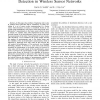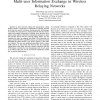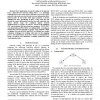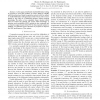112
Voted
GLOBECOM
2008
IEEE
15 years 7 months ago
2008
IEEE
—In this paper, the problem of deploying relay nodes in wireless sensor networks will be considered. A system consisting of a set of sensor nodes communicating to a fusion center...
136
Voted
GLOBECOM
2008
IEEE
15 years 7 months ago
2008
IEEE
—Cooperative spectrum sensing has been shown to greatly improve the sensing performance in cognitive radio networks. However, if the cognitive users belong to different service p...
118
click to vote
GLOBECOM
2008
IEEE
15 years 7 months ago
2008
IEEE
Abstract— This paper presents a low complexity iteratively detected space-time transmission architecture based on Generalized Layered Space-Time (GLST) codes and IRregular Convol...
121
click to vote
GLOBECOM
2008
IEEE
15 years 7 months ago
2008
IEEE
—A joint network coding and superposition coding (JNSC) scheme is proposed for information exchange between more than two users in a wireless relaying network. In this paper we c...
GLOBECOM
2008
IEEE
15 years 7 months ago
2008
IEEE
Given a wireless network where each link undergoes small-scale (Rayleigh) fading, we consider the problem of routing a message from a source node to a target node while minimizing...
110
Voted
GLOBECOM
2008
IEEE
15 years 7 months ago
2008
IEEE
: Direct application of network coding at the physical layer - physical layer network coding (PNC) - is a promising technique for two-way relay wireless networks. In a two-way rela...
111
click to vote
GLOBECOM
2008
IEEE
15 years 7 months ago
2008
IEEE
— In this paper, distributed double-differential coding is proposed to avoid the problem of carrier offsets in amplify and forward protocol based cooperative network with two rel...
GLOBECOM
2008
IEEE
15 years 7 months ago
2008
IEEE
Nowadays, the source localization has been widely applied for wireless sensor networks. The Gaussian mixture model has been adopted for maximum-likelihood (ML) source localization ...
102
click to vote
GLOBECOM
2008
IEEE
15 years 7 months ago
2008
IEEE
—1 In this paper, we consider an amplify-and-forward (AF) wireless relay system where multiple source nodes communicate with their corresponding destination nodes with the help o...
104
click to vote
GLOBECOM
2008
IEEE
15 years 7 months ago
2008
IEEE
—The cognitive radio based IEEE 802.22 wireless regional area network (WRAN) is designed to operate in the under–utilized TV bands by detecting and avoiding primary TV transmis...




